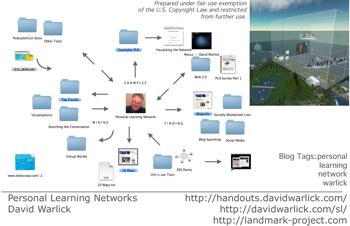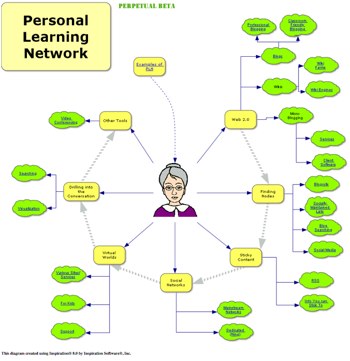I just woke up in my native time zone, but about 8 degrees north of where I woke up yesterday. I’m in London, Ontario, Canada where I’ll open the Western Regional Computer Advisory Committee’s Winter Symposium in a few hours. I spoke here in 2004, following Canadian SciFi writer, Robert Sawyer. I’ll be hanging around after my presentations today to see New Media evangelist Amber MacArthur, or AmberMac. I met Amber and her fiancé, Christopher Dick, at dinner last night and thoroughly enjoyed our conversation and how personable they both were.
THESE GUYS ARE CELEBRITIES!
I will likely live blog Amber’s presentations this afternoon — so stay tuned.
Lately, I’ve been trying to figure out how to make my online handouts easier to use. As per a recent blog post about addressing the needs of a growing range of techno/info savvy educators, I need something that can reach beyond what ever ideas we are able to explore during the face-to-face part of my teaching.
 |
|
|
I continue to believe that graphic organizers or concept maps need to be an key element of the handouts, especially since I’ve started using a graphical arrangement of files when I present from a finder folder on my Mac (see left).
I’ve explored a number of online tools for creating concept maps, and all combined, they do exactly what I want to do, conveniently create a map of interconnected ideas with nodes linking out to web-based information sources. However, no single tool does it all.
I keep coming back to Inspiration, which is incredibly easy to use (especially when you learn the keystroke shortcuts), accepts hyperlinks, can use images as node symbols, and easily outputs to HTML.
 |
|
|
The information resources part was a little bit challenging until I started using Alan Levine’s Feed2JS tool, which I have linked to the front page of Landmarks for Schools. This brilliant tool allows me to paste in an RSS feed from my Delicious account, that aggregates, for instance, all of the web sites I’ve bookmarked and tagged with PLN and visualization. The tool then gives me a Java Script that you can paste in your web page that lists the items from the feed.
I created a single web page (and this is the geeky part of this presentation) that takes a set of tags and title out of a URL, plugs them into Alans feed lister to create a dynamic page that lists those specific bookmarked web sites. The URL looks like this:
- http://landmark-project.com/workshops/rss-links.php?tags=visualization+PLN&title=Visualizing-the-Conversation
- http://landmark-project.com/workshops: The location of the web page
- rss-links.php: The actual page file
- tags=visualization+PLN: The two tags to look for in Delicious
- Title=Visualizing-the-Conversation: The title to be displayed. Here is the actual page.
Now the point of this blog post is not to show you how geeky I can be. There’s nothing here that you, like me, couldn’t teach yourself FAR more easily than you might think.
What reflecting on this reminded me of is how we too often teach technology. We try to teach our children how to use the computer, and then test them on how well they’ve learned what we taught.
However, if you think about how most of us use technology, it isn’t the computer that we’ve learned to use. it’s what we have made of the computer that makes it usable for us.
That probably didn’t make sense, but I suspect that rather than just teaching students how to use a computer, we should be helping them learn to make the computer something that they can use — something that helps them acomplish their goals.
Powered by ScribeFire.

Hello David,
I just wanted to note that your comment below is a great one and one that, for some reason I feel I need to digest a little more before I can put more thoughts down.
“However, if you think about how most of us use technology, it isn’t the computer that we’ve learned to use. it’s what we have made of the computer that makes it usable for us.”
This rings true in very many ways for me. It is forcing me to think of how this applies to both teachers and students as well as the, unfortunately necessary, security measures that many schools take to prevent innappropriate use that would inhibit the type of learning you are referencing.
More thoughts later…
The work that you are doing on a personal learning network is amazing. I’m thinking of defining my work at a digital learning network. The distinction is small but important considering that these networks would be possible without technology. I feel this might work best when explaining to teachers who are new to the digital networks.
Do others have thoughts on this?
James